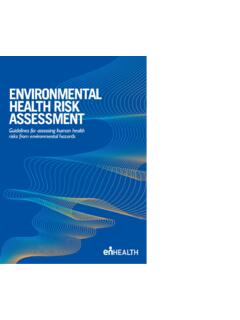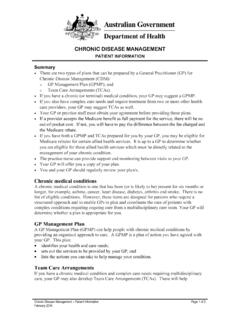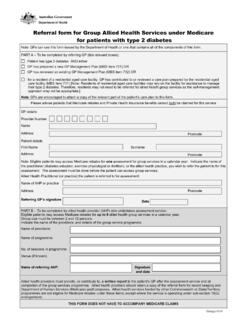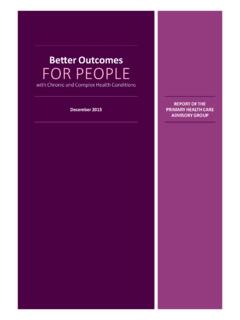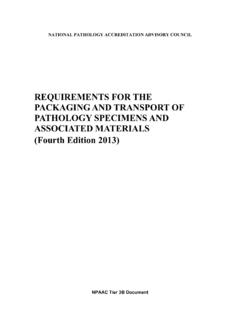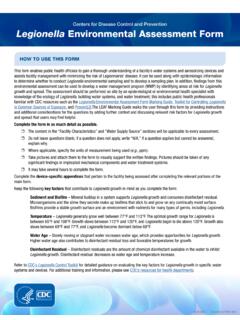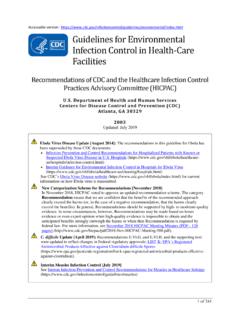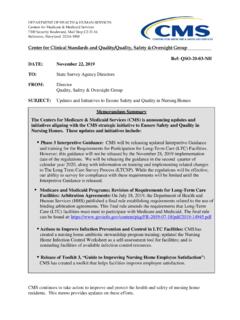Transcription of Legionella Control - Department of Health
1 Australian Government, 2015 Print ISBN: 978-1-76007-270-4 Online ISBN: 978-1- 76007-271-1 Publications approval number: 11432 With the exception of the Commonwealth Coat of Arms, photographs, SA Health logo, and other logos and emblems, any material protected by a trademark, any content provided by third parties and, where otherwise noted, all material presented in this publication is provided under a Creative Commons Attribution Australia licence. Citation: enHealth (2015). Guidelines for Legionella Control in the operation and maintenance of water distribution systems in Health and aged care facilities. Australian Government, Canberra. Edited and designed by Biotext Pty Ltd.
2 Published by SA Health . Postal address: PO Box 287 Rundle Mall Adelaide SA 5000 Telephone: (08) 8226 6599 Email: Internet: Contents Acknowledgements .. 2 Introduction .. 3 1. Establishing a Legionella risk management system .. 6 2. Analysing your risk .. 8 3. Managing your risk .. 18 4. Responding to detections or cases .. 38 5. Reviewing your Legionella risk management plan .. 42 6. Summary .. 43 Abbreviations and definitions .. 44 Appendix 1 Risk assessment tables .. 47 Bibliography .. 48 Guidelines for Legionella Control | 1 Acknowledgements The following individuals and organisations helped to develop and review these guidelines. Government Stuart Adcock, Department of Health and Human Services, Victoria Frances Graham, Ministry of Health , New Zealand Dr Greg Jackson, Queensland Department of Health Dr Chris Lease, Helen Psarras and Andrew Vickers, SA Health , South Australia CETEC Consortium Laura Fitzgerald, Dr Vyt Garnys, Travis Hale and Jack Noonan, CETEC Pty Ltd Dr Paul Bartley, The Wesley Hospital Brad George and Warren Keep, Norman Disney & Young External reviewers Professor Elizabeth Hartland, University of Melbourne Dr Claressa Lucas, Centers for disease Control and Prevention, United States Editors and designers Biotext Pty Ltd.
3 Canberra2 | Guidelines for Legionella Control Introduction Legionnaires disease Legionnaires disease is caused by colonisation of the respiratory tract with Legionella bacteria. It is characterised by severe pneumonia. Unless diagnosed and treated rapidly, the disease can be serious or even fatal, especially in vulnerable people. In Health and aged care settings, the mortality rate from Legionnaires disease is as high as 40 per cent. Pontiac fever is a milder infection caused by Legionella that presents with similar respiratory symptoms as Legionnaires disease but does not result in pneumonia. Pontiac fever usually resolves without treatment in 2 5 days.
4 Legionella bacteria Legionella are small less than 1 micrometre ( m) in width and 3 m in length gram-negative bacteria. They can be found in water, in host organisms such as amoeba, and adhering to the surface of pipes or other plumbing infrastructure (often in a layer formed with other microorganisms called a biofilm ). Legionella can also be found in organic material such as soil, compost and potting mix. To date, around 60 species of Legionella bacteria have been formally identified, and just under half are suspected to cause infections in humans. Legionella pneumophila is known to cause most of the water-related Legionella infections that lead to serious illness.
5 However, in Health care facilities, non Legionella pneumophila species may also cause disease . Infection by Legionella Infection by Legionella occurs following inhalation or aspiration of aerosol droplets containing Legionella bacteria or host organisms infected with Legionella bacteria. The incubation period for Legionnaires disease is usually 2 10 days before the onset of illness, but is typically 5 6 days. However, evidence from some point-source outbreaks shows that the range can be 1 19 days, with a median of 6 7 days, and that some severely immune-suppressed patients may take longer than 10 days to develop symptoms. Why Legionella is a particular problem for Health care When exposed to Legionella , most healthy individuals will not develop an illness, or will develop Pontiac fever rather than Legionnaires disease , but newborn babies, the very old and people with compromised immune systems are at increased risk of Legionella infection.
6 Legionella is therefore of significant concern in Health and aged care facilities because of the presence of people with clinical risk factors that increase both the likelihood and the potential severity of Legionella infection. Guidelines for Legionella Control | 3 In Health and aged care settings, patients with significant clinical risk factors include: newborn babies (water birthing is a particular risk) older people (the disease is rare in children and most cases occur in people over the age of 50) males (in 2013, 54 per cent of Legionnaires disease notifications in Australia and 67 per cent in New Zealand were for males) smokers people with - chronic obstructive pulmonary disease - diabetes - therapeutic immunosuppression - transplant immunosuppression - diseases that result in immunodeficiency (eg HIV/AIDS) people undergoing chemotherapy.
7 These guidelines The design and function of the water distribution system within a Health or an aged care facility can affect the potential Health risks posed by Legionella within the facility. These guidelines are designed to assist facility managers to assess and manage the risk from Legionella in Health and aged care facilities. They are aimed at facility managers and the members of a facility s Legionella risk management team to support the development of a Legionella risk management plan. A plan template is provided separately. The guidelines and template are provided as non prescriptive guidance materials only and where possible they should be adapted to fit with existing facility risk management processes and regulatory requirements, where appropriate.
8 Although the principal focus of these guidelines is Legionella pneumophila, the advice provided about its Control will also result in effective Control of other Legionella species and many other microbial hazards that can be present in the water infrastructure of Health and aged care facilities. These guidelines apply to all water distribution systems in Health and aged care facilities with the exception of cooling towers, which are not within the scope of this document. Facility managers should consult relevant state or territory legislation and guidelines for the management and Control of Legionella in cooling towers. 4 | Guidelines for Legionella Control Structure of these guidelines These guidelines take you through the steps required to manage Legionella risk within your facility.
9 These are: establishing a Legionella risk management system (see Chapter 1), including - assembling a risk management team - developing, documenting and reviewing a risk management plan analysing your risk (see Chapter 2), including - undertaking a system analysis - identifying hazards, hazardous events and risk managing your risk (see Chapter 3), including - implementing controls - monitoring responding to detections or cases (see Chapter 4), including - undertaking corrective measures - responding to a suspected case of Legionnaires disease - deciding what to do if the problem persists reviewing your Legionella risk management plan (see Chapter 5).
10 Guidelines for Legionella Control | 5 1. Establishing a Legionella risk management system Two main components are needed in any system to manage Legionella risk. First, there are the suitably trained and experienced leaders and staff who are aware of the risks and able to act to manage them. Second, there must be an effective and documented Legionella risk management plan that can be followed by the risk management team and other key staff. Assembling the risk management team The responsibility for managing Legionella risk in a facility is a shared one. A facility s risk management team needs to include people who have sound understanding of the risks and Control of Legionella involved in the day-to-day management of the water distribution system and people responsible for the care of patients or residents.

